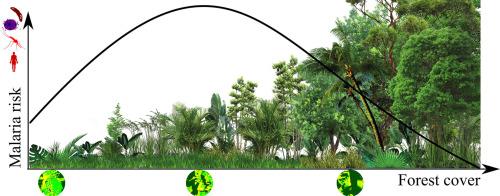亚马逊森林砍伐前沿的中等森林覆盖和疟疾风险。
IF 2.5
3区 医学
Q2 PARASITOLOGY
引用次数: 0
摘要
以按蚊感染率衡量的疟疾暴露风险在亚马逊地区最高,森林覆盖率约为50%,这是该地区的普遍情况。然而,景观配置对受感染病媒密度和人类疟疾发病率的影响仍然知之甚少。在疟疾流行的巴西亚马逊阿克里州森林砍伐前沿的40个地点进行了一项试点自然实验。所选择的地点是在受控条件下代表森林覆盖和森林砍伐水平的梯度。我们收集了蚊子载体(丰度和感染率)和人类疟疾感染的数据,以评估景观结构如何影响传播。森林覆盖率中等且破碎化程度高的地区,nysorhynchus蚊子数量较多,按蚊感染率较高,导致间日疟原虫和恶性疟原虫感染风险增加。检测到的所有人间感染均无症状(n=16),这是一个持续的传播宿主,也是消除疟疾的主要障碍。我们的研究结果表明,即使采用基于抗疟疾药物的干预措施,在中间森林覆盖占主导地位的地区,疟疾传播仍可能持续存在。消除策略应将根治治疗与其他媒介控制方法结合起来,特别是针对户外叮咬的按蚊轻吻库蚊。根据现有森林覆盖的数量,基于景观的战略(森林保护/恢复付款)可能有助于自然地控制病媒种群,并支持消除疟疾和保护亚马逊雨林。本文章由计算机程序翻译,如有差异,请以英文原文为准。

Intermediate forest cover and malaria risk in an Amazon deforestation frontier
Malaria exposure risk, measured by anopheline infection rates, appears highest in Amazonian landscapes with approximately 50 % remaining forest cover, a common condition across the region. However, the effects of landscape configuration on the density of infected vectors and human malaria incidence remain poorly understood. A pilot natural experiment was carried out across 40 sites in a deforestation frontier in Acre state, Brazilian Amazon, where malaria is endemic. Sites were selected to represent a gradient of forest cover and deforestation levels under controlled conditions. We collected data on mosquito vectors (abundance and infection rates) and human malaria infections to assess how landscape structure influences transmission. Sites with intermediate forest cover, often associated with high fragmentation, exhibited higher Nyssorhynchus mosquito abundance and greater anopheline infection rates, leading to increased risk of Plasmodium vivax and P. falciparum infections. All human infections detected were asymptomatic (n = 16), representing a persistent reservoir for transmission and a major obstacle to malaria elimination. Our findings suggest that malaria transmission may persist where intermediate forest cover dominates, even with antimalarial drug-based interventions. Elimination strategies should integrate radical cure treatments with alternative vector control approaches, especially for outdoor-biting Nyssorhynchus anophelines. Depending on the amount of existing forest cover, landscape-based strategies (forest conservation/restoration payments) may help naturally regulate vector populations and support both malaria elimination and Amazon rainforest preservation.
求助全文
通过发布文献求助,成功后即可免费获取论文全文。
去求助
来源期刊

Acta tropica
医学-寄生虫学
CiteScore
5.40
自引率
11.10%
发文量
383
审稿时长
37 days
期刊介绍:
Acta Tropica, is an international journal on infectious diseases that covers public health sciences and biomedical research with particular emphasis on topics relevant to human and animal health in the tropics and the subtropics.
 求助内容:
求助内容: 应助结果提醒方式:
应助结果提醒方式:


